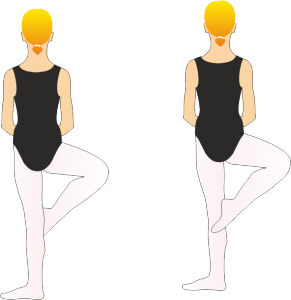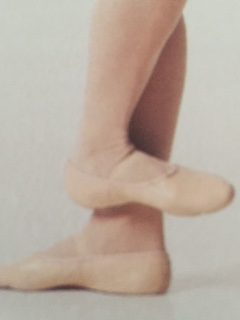The word frappe means to strike or knock and in battement frappe in ballet, this is exactly what the dancer is doing with the working foot on the ground.
What is a Battement Frappe in Ballet?
Some people think of a coffee break when hearing battement frappe, but in ballet, it is a step that is usually done at the barre. It is anything but restful.
The working leg starts sur le cou-de-pied and moves out directly to a slightly lifted position as in a battement glisse, but the foot strikes or brushes the floor on the way there. This could be done to the front, side or back. In most schools of ballet the working leg starts in a flexed position before brushing the floor to an extended position. When the foot returns to sur le cou-de-pied it does not brush the floor.
In the Soviet syllabus, however, in an adoption from the French, the working foot starts from a fully stretched position and barely grazes the floor before extending to an angle of 22.5 degrees. For most schools the accent is on the out, but in the Soviet-style the accent is on the in and the working foot strikes the supporting ankle to rebound out for the next one.
Here is a video so that you can see what a battement frappe in ballet looks like. Pretty impressive!
Why Do We Do Battement Frappe?
Battement frappe is an essential exercise for developing a bright and speedy petit allegro. The strong and brisk outward motion trains the dancers legs and feet to initiate jumps with speed and force. The stop and hold at the end of the movement train a dancer to maintain correct positions in the air.
How To Make The Most Of Battement Frappe In Ballet Class
Here are a few ways in which you can get the most benefit from doing this exercise in class.
- Do the battements frappes with speed, precision, and attack. Make them forceful.
- Keep the hips controlled.
- Hold your supporting side as you extend the working foot.
- Engage your inner thighs and try not to let them jiggle.
- Keep your torso still and well lifted throughout.
Some Variations:

Battements Frappe a Terre is where your working leg extends without brushing the floor, but finishes with the toes touching the floor. The supporting leg can be in a fondu or straight.
Battement Frappe Fouette is where the supporting leg starts at 45 degrees in a la seconde and moves forcefully to a modified retire (as illustrated) in which the working foot is below and crossed in front of or behind the knee of the supporting leg.
Battement Frappe Double is where the working foot beats sur le cou-de-pied back and then front before extending. This is excellent for developing fast and strong legs for allegro in the centre.
So come on dancers, let’s get practising with those battement frappe exercises.
Please comment below if you feel I have left out something, as it is always great to hear from other dancers and teachers.


Hello Michel!
Very informative article you have here. I always knew that with any art form, you need a lot of discipline and strict practice routines in order to improve your skills and nurture your talents. Thus, ballet is no exception.
You have given an in-depth analysis on this ballet technique, which even includes its variations. This will surely be helpful to many young and aspiring ballet dancers who are looking for some guidance.
Awesome post =)
Good to see you back Farhan, and thanks for the kind words.